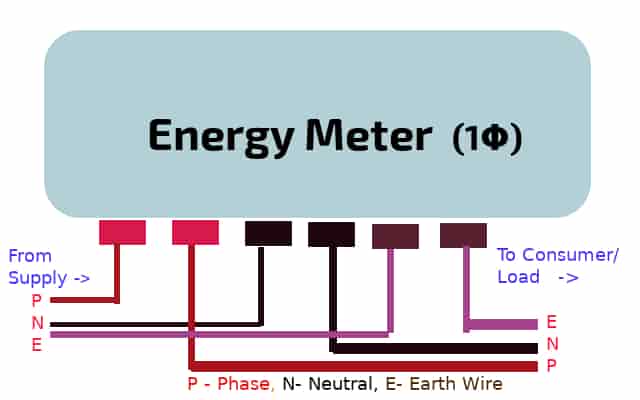Energy Meter: Basics and Connection in a Circuit
Written On Sunday, March 11th, 2018 At 02:12:06 pm By Sunil Saharan
4705 Times
This article describe basics of energy meter, types of energy meters and its connection in the circuit.
Friends,
In Connecting Voltmeter, Ammeter and Watt Meter in a circuit we have discussed how to connect Ammeter, Voltmeter and Watt meter in a circuit. Energy meter is one of the very common instrument that is used frequently used in every house or industry that is connected to the power grid and consumes electrical energy.
Basically two types of energy meter are very common in India and abroad :
 Here one side is supply side and other is consumer side. Three wires are connected to each side viz. P(Phase Wire), N(Neutral Wire) and E(Earth Wire). Earth wire is for safety purpose. Phase wire provide current and Phase and Neutral together provide the potential difference.
Here one side is supply side and other is consumer side. Three wires are connected to each side viz. P(Phase Wire), N(Neutral Wire) and E(Earth Wire). Earth wire is for safety purpose. Phase wire provide current and Phase and Neutral together provide the potential difference.
I hope this article was helpful for you.
In Connecting Voltmeter, Ammeter and Watt Meter in a circuit we have discussed how to connect Ammeter, Voltmeter and Watt meter in a circuit. Energy meter is one of the very common instrument that is used frequently used in every house or industry that is connected to the power grid and consumes electrical energy.
Energy Meter : Definition
Energy Meter, electrical energy meter or energy meter is an electrical device which is used to measure the consumption of electrical energy in a circuit. In short an energy meter records the energy consumed or energy it has passed to the circuit, building or institute to which it is connected. An energy meter measures energy in KWh (kilo watt hour) which is normally called 1 unit of electrical energy. 1 kWh is equal to 3.6 x 106 Joules.Energy Meter : Types
There are a variety of energy meters available in the market or already installed at various locations ranging from 120 years old bulky induction type electromechanical energy meter to latest prepaid electronic based energy meter.Basically two types of energy meter are very common in India and abroad :
- Electromechanical Energy Meter
- Electronic Energy Meter
Electromechanical Energy Meter
This meter works on the principal of electromagnetic induction. It produces two field one proportional to current passing and other proportional to potential different across the terminals. These fields produces two fluxes around the aluminium disc placed between these electromagnets. These fluxes produces a torque and makes the disc move/rotate and these rotations are counted to give energy consumption.Electronic Energy Meter
These are latest and more accurate energy meters. These uses electronic circuit to measure voltage and current in a circuit and then compare this power with the inbuilt timer to give energy consumption.Connection of Energy Meter
Two types of energy meter are installed in domestic and industrial areas. 1 phase or 1Φ in domestic area and 3 phase or 3Φ in industrial area. These meters have almost similar connection arrangement as shown in the figure below: Here one side is supply side and other is consumer side. Three wires are connected to each side viz. P(Phase Wire), N(Neutral Wire) and E(Earth Wire). Earth wire is for safety purpose. Phase wire provide current and Phase and Neutral together provide the potential difference.
Here one side is supply side and other is consumer side. Three wires are connected to each side viz. P(Phase Wire), N(Neutral Wire) and E(Earth Wire). Earth wire is for safety purpose. Phase wire provide current and Phase and Neutral together provide the potential difference.
I hope this article was helpful for you.
Tags :Energy Meter Connection, Energy Meter Basics, Energy Meter Definition, energy meter types
Article Was Last Updated on Sunday, March 11th, 2018 At 02:12:06 pm
Follow steps described here at your own risk. Privacy Policy
भीड़ हमेशा उस रास्ते पर चलती है जो रास्ता आसान लगता है, लेकिन इसका मतलब यह नहीं की भीड़ हमेशा सही रास्ते पर चलती है| अपने रास्ते खुद चुनिए क्योंकि आपको आपसे बेहतर और कोई नहीं जानता|
Site Statistics
Stats at a Glance
Articles: 54
Viewed: 400783 Times
Photos : 53
Viewed: 580721 Times
Questions : 2344
Viewed: 290525 Times
Page Load No. 3278480
Photos
Take Quiz
1 Liners For Exam
Show Questions(1 by 1)
©2011-2023 SunilSaharan.In




